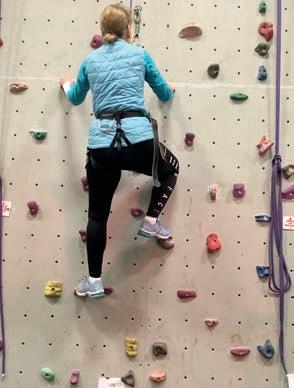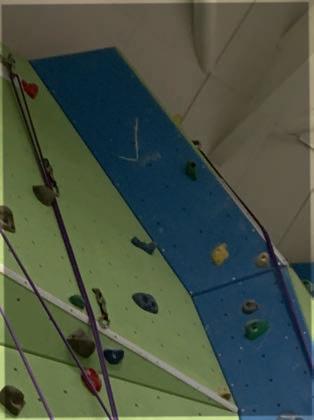
6 minute read
Give It A Go
Tackle the Wall Tackle the Wall

Advertisement

Reach Outdoors runs an indoor climbing wall at Park eld in Paignton and there’s a weekly open climbing evening on ursdays from 6.30pm. Anita Newcombe went along to give it a go!
Anita and senior instructor Abi Hone
After parking behind the Park eld centre o Colin Road in Paignton, I meet Senior Instructor Abi Hone, who is busy checking in climbers of all standards. e Park eld wall has 18 xed ropes and over 60 climbing routes o ering grades of climb for beginners right through to expert climbers.
Abi introduces me to Apprentice Instructor Chloe Whitehurst and then gets me to complete some paperwork that will allow me to have a go this evening. Helmets are available, but the climbing wall is considered very low-risk, as there’s little that can fall on you here. So helmetless but strapped into a harness, I am ready. e climbing harness consists of a strong, adjustable waist belt with leg loops and a belay loop. I tighten all the straps to get a good t and I am ready to climb. e safety rope will be tied to my belay loop before I start heading up the rst route.
I’ve been watching a few other people scoot up the various routes with apparent ease, and now it’s time for me to have a go. Abi shows me how to tie a gure-of-eight knot plus the stopper knot that is used to secure the rope to my belay loop. I am buddied with someone I’ve just met called Steve and he’s going to be belaying me. at means he is responsible for controlling the safety rope to stop me falling; it seems like the ultimate expression of trust (but Abi is keeping a close eye on things).



ere are various routes that you can take on each section of the wall and these are denoted by climbing hand holds in di erent colours. Some routes are easier than others but once I get on the wall I stop noticing the colours and just climb, putting my hands and feet wherever I can get a good grip. Not all the holds are easy. ere are big, fat holds in which you can put your whole hand, holds with tiny little edges that you can grip only
with your ngertips and many other ones of various shapes and sizes. I put my feet wherever they feel most secure. Gradually I am inching upwards – this is epic!
Once at the top it starts to feel quite high – quick glance down – eek - and I’m staring straight at the wall again, which bizarrely feels safer. Ok it’s time to head back down. Abi tells me to lean out from the wall, (I’m held securely by the safety rope) and place my feet at against the wall. My climbing buddy Steve is now gradually giving me some slack in the rope so that I can walk backwards down the wall. Soon I am down with my feet rmly back on the ground.
Now it’s time for me to have a go at belaying. ere are various kinds of belay device and the one we’ve just used for my climb, Abi tells me, is called a bug. Reach Outdoors use di erent types of device for teaching purposes so that climbers are familiar with the main ones. But this time we are going to be using a di erent belay
device with assisted braking. It is threaded with the rope and attached to a carabiner that, in turn, attaches to the belay loop on my own harness. Abi explains that the ‘live’ end of the rope is attached to the climber and that I will use the ‘dead’ end to tighten or slacken the rope.
Steve and I check each other’s xings and o he goes. Abi shows me how to stand squarely with slightly relaxed knees, pull in the rope as he climbs and hold the rope in a locked position when he’s not moving. Once Steve is at the top, I need to reverse the procedure, gradually releasing the rope to give enough slack for him to descend but not so much that he can fall any distance.
Before having another go I chat to a couple of other climbers. Dave Pressley says, “Are you the person who wrote the Everest Base Camp trek article?” I con rm that I am and we start chatting about various expeditions we have both done. Dave is climbing tonight with Jo Taylor; they are both keen climbers who also enjoy via ferrata routes (a climbing route equipped with steel cables, ladders, and other xed anchors).
Now we are ready to start again and I have a couple more goes at climbing and belaying with Steve, each time on a di erent (and seemingly harder) route. I’m starting to get accustomed to the experience and all the di erent routes are great fun to try.
Once you’ve been signed o as a competent belayer you can climb the wall independently with friends and family (currently £5 per person, per session). Under-18s have to be supervised by an adult competent in belaying and have signed consent from a parent or guardian. Regular hourlong Taster Sessions, like the one I’ve just experienced, are held on ursday evenings and cost £12 per person with a minimum of 2 and a maximum of 6 people per group – advance booking is essential. ere’s a minimum age of 7 years old (and under-18s still need signed consent prior to the session).
Once you’ve got the bug, there are Induction Sessions, 4-week Intro to Climbing Courses (Indoor to Outdoors) plus a Youth Climbing Club for 14-17 year olds. Private bookings can also be arranged for kids or adults’ birthday parties or groups of friends or colleagues wanting to climb together. Climbing here is certainly a fun and exhilarating activity, safe but exciting and also sociable. Why not give it a go? reach-outdoors.com



Learning to use the belay bug
Leave more than memories, give the gift of care for the future





During Make a Will Week, local solicitors waive their entire fee for making or updating your Will, in return for a donation to Rowcroft.


Every donation will provide care and support to patients and families in South Devon living with life-limiting illnesses, enabling them to make the most of every moment they share.
For more information: rowcrofthospice.org.uk/willweek Call 01803 217405











